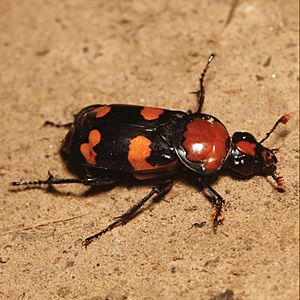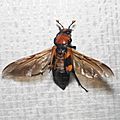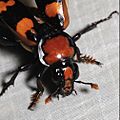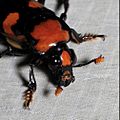American burying beetle facts for kids
Quick facts for kids Nicrophorus americanus |
|
|---|---|
 |
|
| adult female | |
| Conservation status | |
| Scientific classification | |
 |
|
| Synonyms | |
|
The Nicrophorus americanus, also known as the American burying beetle or giant carrion beetle, is a type of beetle. It is critically endangered, meaning it is at high risk of disappearing forever. This beetle lives only in North America. It belongs to a group of beetles called carrion beetles, which means they eat dead animals. They also need dead animals to have babies.
The American burying beetle is special because both parents help take care of their young. Sadly, these beetles are now found in less than 10% of the places they used to live. This is mainly because their homes have been lost or changed.
Contents
What Does It Look Like?
Adult American burying beetles are about 25 to 45 millimeters (1 to 1.8 inches) long. They are easy to spot because of their unique colors. Their bodies are shiny black. On each wing cover (called an elytron), they have two wavy, orange-red marks.
A special orange-red mark on their upper body (called the pronotum) helps tell them apart from other beetles in North America. The front of their head has two orange spots. One is on their forehead (frons), and a smaller one is above their mouth (clypeus). The orange spot on the clypeus is smaller and more triangle-shaped in females than in males. The tips of their feelers (antennae) are mostly orange. These adult beetles are active at night and can fly as far as a kilometer (about half a mile) in one night!
Where Do They Live?
Long ago, this beetle lived in 35 states in the United States and two provinces in Canada (Ontario and Quebec). Today, you can only find natural groups of them in ten states. These include Rhode Island (on Block Island), Oklahoma, Arkansas, Texas, Kansas, South Dakota, and Nebraska. Scientists have also brought them back to Ohio, Massachusetts, and Missouri.
Reproduction and Life Cycle
During the colder winter months, when temperatures drop below 15°C (60°F), adult American burying beetles dig into the soil to sleep. This is called overwintering. When it gets warmer, above 15°C (60°F), they come out of the soil to find mates and have babies.
It's unusual for insects, but both the male and female beetle help raise their young. Often, the male beetle finds a dead animal first. Then, he attracts a female. Beetles might even fight over the dead animal, with the biggest male and female usually winning. The winning pair then buries the animal. The female lays her eggs in a tunnel right next to it.
In a few days, the eggs hatch into tiny larvae (baby beetles). Both parents feed and care for their young. This is a rare behavior among insects, but earwigs also do it. A beetle family usually has 1 to 30 young, but 12 to 15 is common.
The larvae eat the buried animal for about a week. Then, they crawl into the soil to change into pupae. This is like a resting stage where they transform. About 45 to 60 days after their parents buried the animal, new adult beetles emerge from the soil. American burying beetles usually live for only about 12 months.
How They Live and Behave
We don't know much about what kind of home the American burying beetle preferred in the past. Today, we know they can live in many different types of places. They seem to like grasslands and open oak and hickory forests best.
However, these beetles are very picky about their food. They need dead animals, like a dove or a chipmunk, to have babies. So, having enough dead animals around is probably the most important thing for where these beetles can survive.
Conservation Status
The American burying beetle was listed as an endangered species in 1989. The IUCN (a group that tracks endangered species) still calls it critically endangered. Scientists are not completely sure why these beetles have disappeared from so many areas.
One idea is that widespread use of pesticides might have harmed them. However, they started disappearing even before many pesticides like DDT were widely used. Another big reason might be the lack of small dead animals for them to bury. Changes in how land is used have reduced the number of small- to medium-sized birds and mammals that these beetles need. Even the disappearance of the once common passenger pigeon might have affected them.
The main goal of conservation efforts is to stop them from becoming extinct. Biologists are trying to create new groups of beetles, both in special labs and in the wild. For example, they have released lab-raised American burying beetles on Penikese Island and Nantucket island in Massachusetts. Scientists go back to these islands every year to see how the beetle populations are doing.
In 2020, the U.S. Fish and Wildlife Service changed the beetle's status to "threatened." This means they are still at risk, but not as critically as before. The American burying beetle still faces dangers from climate change, especially in the warmer parts of its range. They are also threatened by new buildings and roads that destroy and break up their homes.
Images for kids
See also
 In Spanish: Escarabajo enterrador americano para niños
In Spanish: Escarabajo enterrador americano para niños







